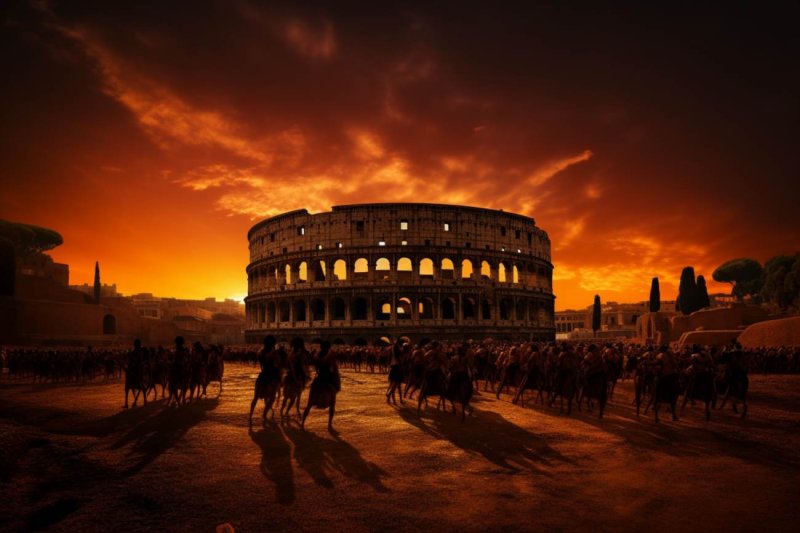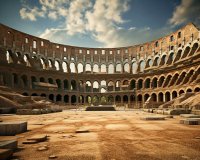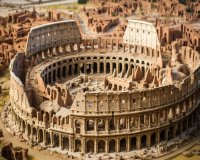Unearthing Rome’s Time Capsule

Unearthing Rome's Time Capsule: Journey through the Colosseum and Palatine Hill
Rome, the eternal city, is a treasure trove of history, with each stone and artifact telling a story of a bygone era. Among the many archaeological wonders that grace the city, the Colosseum and Palatine Hill stand as iconic time capsules that transport us to the grandeur of ancient Rome.
Stepping into the Colosseum, you can almost hear the roar of the crowd and the clash of gladiators' weapons. This colossal amphitheater, also known as the Flavian Amphitheatre, was built in AD 70-80 and could accommodate up to 80,000 spectators. Its elliptical design and towering walls remain a marvel of Roman engineering.
As you walk through the labyrinthine corridors of the Colosseum, it's impossible not to feel the weight of history. Gladiatorial combat, chariot races, and mock sea battles were once the center of entertainment, and the arena witnessed both the glory and the tragedy of countless lives.
From the Colosseum, the path leads to Palatine Hill, one of the most ancient parts of the city. According to legend, this is where Rome was founded by Romulus and Remus, the twin brothers raised by a she-wolf. The hill served as the aristocratic center of ancient Rome, where emperors and nobility resided in luxurious palaces.
Palatine Hill offers a breathtaking view of the Roman Forum and the Circus Maximus, providing a glimpse into the heart of ancient Rome's political and social life. The lush gardens and impressive ruins make it a serene and picturesque site that contrasts with the grandeur of the Colosseum.
The Preservation Efforts
The Colosseum and Palatine Hill have been the subjects of extensive preservation and restoration work. The Italian government, in collaboration with international organizations, has undertaken initiatives to protect these historical sites from the ravages of time and pollution.
The Colosseum, for example, has undergone extensive cleaning to remove centuries of grime and pollution, revealing the original brilliance of the travertine façade. It's a reminder of the architectural prowess of the ancient Romans. In recent years, there have been efforts to restore the underground chambers of the Colosseum, which were used to house animals and gladiators before the games.
Palatine Hill, too, has benefited from restoration projects. The crumbling palaces and structures have been stabilized, and ongoing archaeological excavations continue to unearth new insights into ancient Roman life. Visitors can now wander through the ruins and marvel at the opulence of the past.
Visiting the Colosseum and Palatine Hill
Visiting these historical sites is a journey back in time. To make the most of your visit, consider the following tips:
- Plan your visit during the early morning or late afternoon to avoid the crowds and the scorching midday sun.
- Wear comfortable walking shoes as there is a fair amount of walking and climbing involved.
- Get a guided tour to fully appreciate the historical context and significance of the sites.
- Don't forget to bring water, sunscreen, and a hat to stay comfortable in the Roman sun.
Conclusion
Unearthing Rome's time capsule by exploring the Colosseum and Palatine Hill is an unforgettable experience. These sites bear witness to the rise and fall of one of the greatest civilizations in history. They remind us of the architectural genius, cultural richness, and the complex tapestry of life in ancient Rome. As you wander through the Colosseum and gaze upon the ruins of Palatine Hill, you can't help but be awed by the enduring legacy of the eternal city.
Rome: Discover Myths and Legends of the Roman Forum on a Semi-Private Guided Tour
Embark on an enriching journey through the heart of the Ancient Roman Empire with our semi-private guided tour of the Roman Forum. Immerse yourself in captivating myths, legendary tales, and the gods that once shaped Rome's identity. Wander through the historical gems of Palatine Hill at your own pace, steeped in the essence of an era long past.
About this Guided Tour
Designed to captivate visitors of all ages and backgrounds, our tour offers a deep dive into the rich history of Rome. Kids will be spellbound by ancient stories, while adults will appreciate the intricacies of one of history's most influential civilizations. Explore the myths that molded beliefs and values, from the founding of Rome by Romulus and Remus to the stories of iconic figures like Julius Caesar. Walk in the footsteps of brave soldiers and astute politicians, gaining insights into the once-mighty empire's core.
Key Highlights
- Small-group experience limited to 10 participants, ensuring an intimate and unforgettable exploration.
- Professional and amiable guide providing an immersive narrative.
What to Expect
Step into a world where history comes alive, regardless of your age or background. Delve into the fabric of Rome's myths and legends, a potent tapestry of belief and narrative. Traverse the historic center of the Roman Empire, gaining profound insights into its gods, myths, and legends.
Inclusions
- Entrance ticket to the Roman Forum, Palatine Hill, and Imperial Forums.
- Engaging guided tour in English, offering a captivating narrative.
- Comfortable headset for clear guidance, ensuring an enriching experience for groups larger than six.
- Convenient meeting point at L.go della Salara Vecchia, 00186 Roma, easily identifiable by the Kirba Tours sign or flag.
Meeting Point and Important Information
Meeting Point: L.go della Salara Vecchia, 00186 Roma. Look for the Kirba Tours sign or flag.
What to Bring: Passport or ID card for adults and children.
Prohibited Items: Pets, weapons or sharp objects, luggage or large bags, and glass objects.
Security Measures: A metal detector security check is mandatory to enter the Roman Forum.
Group Ticket Policy: One group ticket will be issued, and individual tickets for late arrivals are not possible.
Book now to embark on an unforgettable journey through the myths and legends of ancient Rome.
Delving into the History of the Colosseum, Rome
The Colosseum, one of Rome's most iconic landmarks, stands as a symbol of ancient Roman engineering, architecture, and entertainment. With its rich history spanning nearly two millennia, this monumental amphitheater has captured the imagination of people worldwide. Let's delve into the fascinating history of the Colosseum and uncover the stories hidden within its walls.
The Birth of a Colossal Monument
Construction of the Colosseum, originally known as the Flavian Amphitheatre, began in AD 70-72 under the emperor Vespasian of the Flavian dynasty. The massive structure was completed in AD 80 by his son Titus. The Colosseum was built to accommodate a vast audience, with a seating capacity estimated between 50,000 and 80,000 spectators.
With a circumference of 545 meters and a height of 48 meters, the Colosseum was a true engineering marvel of its time. Its elliptical shape and tiered seating allowed for efficient crowd management, and the amphitheater could be filled and emptied rapidly.
Entertainment and Spectacle
The Colosseum was primarily used for various forms of public entertainment, including gladiatorial contests, animal hunts, and mock sea battles. These events were not only a source of amusement but also served political and social purposes. Emperors used the games to gain favor with the people and demonstrate their power and wealth.
Gladiator battles were among the most renowned events held in the Colosseum. These fights pitted trained warriors against each other or against wild animals, often resulting in bloodshed and fatalities. The Colosseum's underground passages housed animals and gladiators, adding to the intrigue of these combats.
The Decline and Abandonment
As the Roman Empire declined, so did the Colosseum's glory. The last recorded gladiator games took place in AD 435. The amphitheater saw various uses over the centuries, including as a quarry for building materials. Earthquakes, fires, and time took their toll on the structure, reducing it to a fraction of its original grandeur.
The Colosseum's abandonment allowed plants to grow within its walls, and it became a picturesque ruin in the heart of Rome. However, its historical and architectural significance was recognized, and preservation efforts began in the 19th century.
Modern Restoration and Legacy
In recent centuries, the Colosseum has undergone significant restoration and preservation efforts, ensuring that future generations can marvel at its grandeur. Today, it is one of Rome's most visited attractions, drawing millions of tourists annually.
The Colosseum serves as a powerful reminder of ancient Rome's glory, engineering prowess, and the often brutal forms of entertainment that captivated the Roman populace. It has been featured in numerous films, books, and artworks, solidifying its status as a symbol of both Rome and human history.
In conclusion, the Colosseum in Rome is more than just a colossal structure; it is a window into the past, revealing the grandeur and complexity of ancient Roman society. Its history is a testament to the enduring fascination with the remnants of a bygone era, and it continues to inspire awe and admiration in people from all corners of the globe.
Rome: Explore Ancient Wonders with Colosseum and Roman Forum Tickets
Immerse yourself in the rich history of Rome with entry tickets to the Colosseum, Roman Forum, and Palatine Hill. This comprehensive experience offers a fascinating journey through ancient Roman life, complete with a captivating multimedia video providing insights into the city's past.
Start your adventure at the activity provider's office, located at Piazza D'Ara Coeli 16. Here, you'll collect your tickets and delve into a 25-minute multimedia presentation on ancient Rome. The tour encompasses the Roman Forum, Palatine Hill, and culminates with the awe-inspiring Colosseum.
Embark on a self-guided exploration of the Roman Forum, where the echoes of daily Roman life still linger. Marvel at the tomb of Emperor Julius Caesar and wander through the ancient ruins at your own pace. Continue your journey to the Palatine Hill, the birthplace of Rome, and the residence of emperors and kings.
The highlight awaits as you step into the colossal Colosseum, the grand amphitheater that witnessed gladiator fights, executions, and spectacular animal hunts. The entrance to the Colosseum is approximately 2 hours after the meeting point time, providing you with ample time to absorb the historical significance of each site.
These tickets offer access to the Roman Forum, Palatine Hill, and the Colosseum, providing a comprehensive archaeological experience. Enjoy the convenience of an audio guide available in multiple languages, including English, Italian, French, German, Portuguese, Japanese, Chinese, Russian, and Spanish.
Before embarking on this educational journey, be sure to exchange your voucher for entrance tickets at the Touristation office, Piazza Ara Coeli, 16. Families with children will receive special assistance to the entrance of the Roman Forum.
For an unforgettable exploration of Rome's ancient wonders, book your spot now and pay later. Keep your travel plans flexible and dive into the heart of ancient Rome with this immersive ticket package.
Includes:
- Entry ticket to the Roman Forum
- Entry ticket to the Palatine Hill
- Entry ticket to the Colosseum
- Assistance at the meeting point
- 30-minute ancient Rome multimedia video
- Paper city map
- WiFi
- Toilet lounge
Important Information:
- Bring your passport or ID card for adults and children
- Prohibited items include pets, large bags, alcohol, drugs, sprays or aerosols, and glass objects
- The Roman Forum and Palatine Hill must be visited for approximately 2 hours before entering the Colosseum
- These tickets are not valid for school groups, group guided tours, and private guided tours
Don't miss the chance to witness the marvels of ancient Rome — book now and embark on a historical journey like no other!
The Mysteries of Palatine Hill, Rome
Palatine Hill, one of the most ancient parts of Rome, is a place steeped in history and shrouded in mystery. This legendary hill, which stands at the center of the Seven Hills of Rome, holds secrets and stories that have captured the imagination of historians, archaeologists, and visitors for centuries.
So, what are these mysteries that make Palatine Hill such a fascinating place? Let's delve into the enigmatic allure of this historic site.
The Founding of Rome
One of the greatest mysteries surrounding Palatine Hill is its connection to the founding of Rome. According to Roman mythology, Palatine Hill was the location of the cave where the she-wolf, Lupa, nursed the twin brothers Romulus and Remus, who went on to establish the city of Rome. The truth behind this legend remains a topic of debate, but it adds a layer of mystique to the hill's history.
The Palace of the Emperors
Palatine Hill was not only the birthplace of Rome but also the chosen location for the luxurious palaces of Roman emperors. The grandeur of these palaces was unparalleled in the ancient world, and the exact layout and architecture of many of these structures remain a subject of intrigue. The Domus Augustana, Domus Flavia, and other palatial complexes on the hill have been excavated and partly reconstructed, revealing the opulence of the Roman Empire.
The House of Augustus
One of the most significant archaeological discoveries on Palatine Hill was the House of Augustus, the first emperor of Rome. This modest house, hidden for centuries, was uncovered in the 1960s and provided valuable insights into the life of the most powerful man in the ancient world. The vivid frescoes and personal artifacts found within the house offer a glimpse into the private life of Augustus.
The Hidden Passageways
Beneath Palatine Hill, there exists a network of subterranean tunnels, chambers, and passageways. These mysterious underground areas have been a source of fascination for historians and adventurers alike. The purpose of these passages is not entirely clear, but they are believed to have served various functions, including transportation, storage, and religious ceremonies.
The Farnese Gardens
Amidst the ruins of Palatine Hill, the Farnese Gardens stand as a testament to the Renaissance era. These gardens, established by Cardinal Alessandro Farnese in the 16th century, blend beautifully with the ancient ruins. The Farnese Gardens are a place of serenity and natural beauty, offering stunning views of the surrounding city.
The She-Wolf Statue
One of the most iconic symbols of Rome is the Capitoline Wolf, a bronze statue depicting the legendary she-wolf that cared for Romulus and Remus. This statue has a place of honor on Palatine Hill, near the entrance. Its origins and significance are subjects of debate and continue to captivate both scholars and visitors.
Conclusion
Palatine Hill, with its rich history and lingering mysteries, remains a must-visit destination for those exploring the eternal city of Rome. It's a place where legends and reality intertwine, creating an enchanting tapestry of the past. As you walk amidst the ruins, you can't help but feel the weight of history and the allure of the enigmatic stories that continue to be unearthed on this ancient hill.






